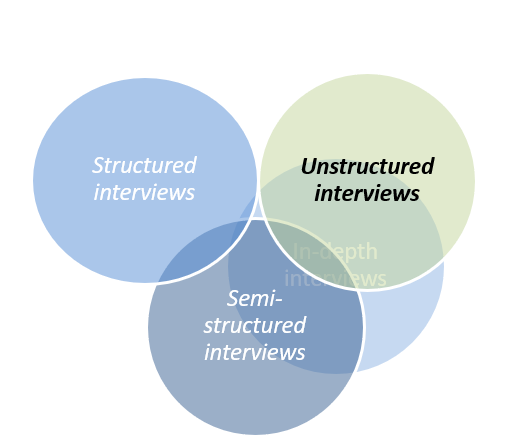Unstructured interviews: Less like ‘a chat’ and more like a research conversation
At its most simple, if you are simply using the unstructured interview as tool with minimal reference to epistemological positions, an unstructured interview is an opportunity for your participants to talk and determine the direction of that talk, and for you to listen.

Continuing the theme of depth and structure in research interviews, this blog focuses on unstructured interviews. At its most simple, an unstructured interview is an opportunity for your participants to talk, determine the direction of that talk and for you to listen. How long that goes on for, and whether it is a one-off or a repeated meeting depends on the purpose of the research and what has been agreed. Some stimulus material and or research admin (e.g. permissions and consent) should be enough to frame the start and end of the conversation, the rest is determined by following the flow of talk.
You could be forgiven for thinking that this style of research interview is just a chat, as a chat is indeed unstructured talk. Unstructured talk goes where-ever those involved want it to go and conversation means “wandering together with” (Kvale, Steinar; Brinkmann, 2009). There is often a degree of turn-taking and sharing of information that characterises both a chat and a conversation. However, once themes and topics move on from culturally light topics (e.g. weather, traffic, unsubstantiated opinions i.e. just a chat), this tends to be given the more formal term of ‘conversation’. Unstructured interviews can also be known as Research conversations. This is not to be confused with scholarly conversation about research, such as you might find in an editorial or pages of a journal, or scholars having conversations in a scholarly fashion about the world, as you might find in the The Conversation.

Research conversations share a common purpose with Unstructured interviews in that the focus is to create insight or explore unfamiliar perspectives in a way that places the participant and interviewer as the same status in the interview context. In a Research Conversation, having negotiated and agreed the purpose and limits of the topic, all members are supposed to have equal power and voice. Having encouraged you to listen whilst your participants talk, there is an expectation that there is some give and take in a Research Conversation. Qualitative research has been criticised for expecting the participant to give everything; having to explain and justify their non-normative positions and contexts, whilst the researcher gives nothing of themselves, simply acting as a representative of the all-powerful edifice of the academy. It is important as a critical researcher that you reflect upon and understand your subjective position in the interview dyad, and what the purpose and limits are to your sharing in any InterView (Kvale, 1996).
Research Conversations have also been criticised as a method that encourages narcissistic interventions and constructions by researchers that have little to do with the co-production of knowledge, but serve as a vehicle for egotistical researchers to co-opt the knowledge of others and present it as their own. There is a risk that the researcher and participants could end-up re-enforcing each-others’ narratives unless the researcher reflects critically on the co-constructed narrative produced.
But when done well, when a researcher is able to negotiate, develop rapport and enter a conversation with an informant with genuine intent, they will be rewarded with the interaction itself and a level of research depth that a semi-structured interview does not normally achieve.
Gathering data
When are unstructured interviews used?
Wolfson (1982) argued that “conversational narrative is a fuller form in which to share the meanings of experience, whilst interview narrative tend to become reports or summaries.” They are fuller in that conversational narrative are performed, whilst those told in interviews are not (in Cozztazzi, 2001:390). However unstructured interviews do not have the wide range of suitability that semi-structured interviews have. Whatever epistemological approach you take to your unstructured talk, you will need to have an informant who has something to say, and is willing to explore what they are saying, or their agenda with you. Deep specialists with something to say are ideal candidates.
Examples could include:
· Life histories
· Ethnographic interviews
· Collaborative research
· Participatory action research
Consider carefully your ethics application, as anonymisation may be inappropriate in this type of research. Honouring real names and places can be an important part of acknowledging cultural ownership of data, and facilitating recognition of this ownership. This can be especially important in some forms of ethnographic research, where cultural knowledge has systematically been denied, misrepresented and appropriated, by the academy (Smith, 2022)
Can I ask questions in an unstructured interview?
Yes, but they should be of the sort that invites a story on a theme. What was the best thing that happened? When was the saddest time of your life? Can you remember when you last got angry about that? Notice that the focus is on events that have happened to them; their experience. So, even though they are rather closed questions, the rapport, respect, and relationship that you have worked together to establish should mean that prompts are received as an invitation to speak openly about their life. The meaning derived from the stories can be then be elicited and co-constructed later in the interview.
Analysing unstructured interviews
Whilst there is no expectation that participant will be involved in the post interview analysis task, it is appropriate to create opportunities to explore what the story is that is being told, and examine whose story it is. This is not the same thing as summarising or paraphrasing a story for neat re-telling. It is a means of acknowledging tensions around ownership, and promoting respectful negotiation of the re-telling of someone’s story, and your position as a researcher in its production (Heyl, 2001). One way to do this is to use and reflect the name and terms used by the informant. Also, remember that most of us have multiple identities. Reports of research narratives have a horrible tendency to ignore this, and miss the opportunities for exploring the inter-sections, interstices, and the liminal aspects of a life. Don’t wait until the interview is over to explore the intersections of identity and the spaces in between (Cortazzi, 2001).
Further Reading
If unstructured interviews interest you, I would advise further reading on Narrative Turn, or at the very least, Conversational Units (without having to go down the route of Conversation Analysis, which is a very specific way of analysing spoken interactions (not all of which are conversations) e.g. business meeting, patient consultation with a GP, customer seeking advice from a technical advisor). Or you could start with our blog How can I get them to talk? Talking naturally in qualitative research interviews.
If you are looking for a tool to analyse the transcripts of your unstructured interviews, give the free trial of Quirkos a go - it's a simple and visual tool to help you explore and analyse all kinds of qualitative data.
References
Cortazzi, M. (2001). Narrative Analysis in Ethnography. In L. Atkinson, Paul; Coffey, Amanda; Delamont, Sara; Lofland, John; Lofland (Ed.), Handbook of Ethnography (pp. 384–394). SAGE PublicationsSage UK: London, England.
Heyl, B. S. (2001). Ethnographic Interviewing. In L. Atkinson, Paul; Coffey, Amanda; Delamont, Sara; Lofland, John; Lofland (Ed.), Handbook of Ethnography(pp. 369–383). SAGE PublicationsSage UK: London, England.
Kvale, Steinar; Brinkmann, S. (2009). InterViews: Learning the craft of qualitative interviewing. Sage. Los An-geles, CA.
Kvale, & Steinar. (1996). InterViews: An introduction to qualitative research interviewing. Sage PublicationsSage CA: Thousand Oaks, CA.
Smith, L. T. (2022). Decolonizing Methodologies: Research and Indigenous Peoples(3rd ed.). Bloomsbury.
Keywords: unstructured interview; interviews; research conversation; narrative; rapport;
